Transplanting strawberries to a new location in the fall
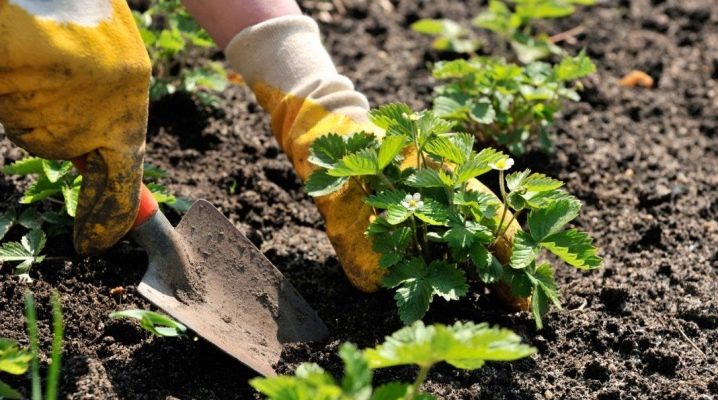
Many gardeners are cultivating strawberries. Everyone wants to get a good harvest, but for this you need to provide the plant with proper care. Strawberries need not only watering, pruning and feeding, but also periodic replanting of bushes. You should choose the right place and time, as well as follow the advice of professionals. In this article, we will talk in more detail how strawberries are transplanted to a new place in autumn.

The need for a procedure
Transplanting strawberries to a new place in autumn is a must, because it helps plants rejuvenate and improve their yield. Quite often, during the autumn transplant, they use the method of dividing the bushes or using antennae. There is no need to transplant an adult strawberry bush to another place, the number of fruits will not increase, since it is young plants that are characterized by high yields.
Professionals usually resort to transplanting strawberries in the fall in the following cases:
- after a few years, strawberries bear fruit with small and not juicy berries, and sometimes they stop bearing fruit altogether;
- the soil in 2-3 years loses microelements, which are very necessary for the active development of plants;
- over time, fungus and bacteria appear in the soil - if you transplant strawberries on time, you can avoid both various diseases and the complete death of the flower;
- high arrangement of antennae on the stem, because during winter they freeze, which accelerates the aging process;
- the presence of lowlands and the accumulation of groundwater.
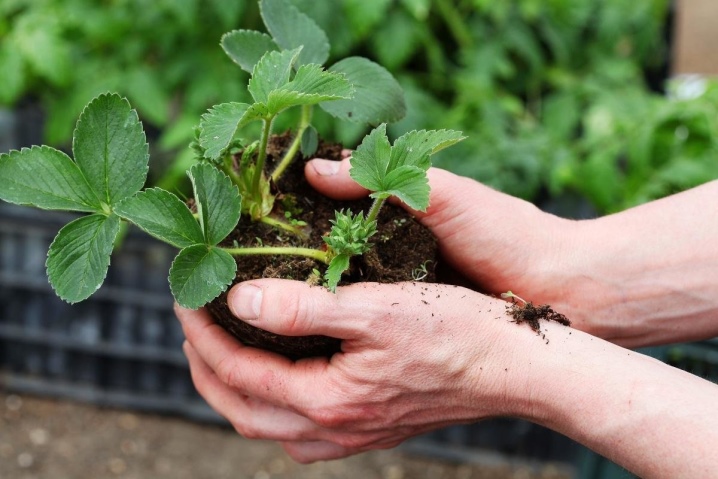
Is it better to replant in spring or autumn?
Strawberries or strawberries can be transplanted in both spring and autumn. There are several factors to consider when choosing the timing.
- To carry out planting in early spring, it is necessary to carry out preparatory work in the fall. If the decision is made to transplant in the fall, then only two weeks are enough for preparation. If last year there were no actions to prepare the land for planting, then it is better to transplant later, for example, in summer or autumn. The choice depends on the region.
- If in springtime the seedlings are weakened after a harsh winter, it is better to transplant in the fall. Usually by this time they give a fairly strong material for planting. As a result, the plants are characterized by high yields.
- If you transplant in the spring, then the first berries will be only next spring. Planting in the fall provides a rich harvest in the coming spring.
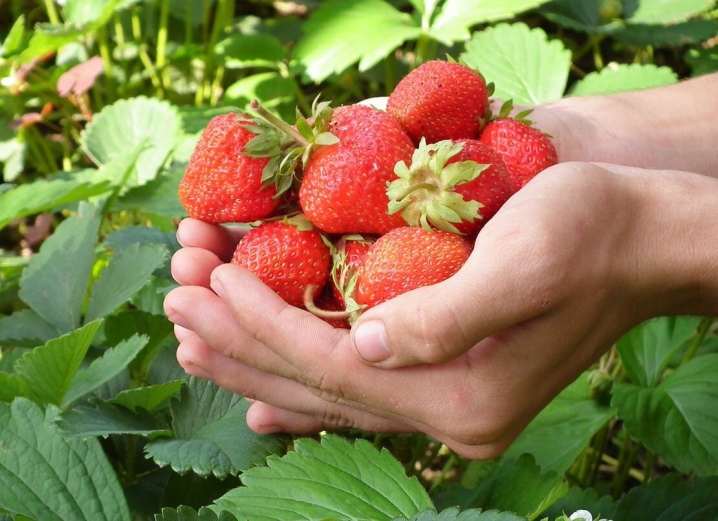
Transplanting in the spring is carried out at different times, as it depends on the region. The temperature regime affects the planting time: from April to June. This period ends as soon as buds appear on the plant. With their appearance, the planting process stops. It is possible to start transplanting strawberries again only after the end of the fruiting process.
You can start replanting strawberries in the spring only after the soil warms up to a depth of 0.1 m, otherwise the plants will simply die. If frosts continue in the spring, then the transplant is postponed until later. In this case, it is better to use an autumn transplant.
The best time is when the earth is warmed up, and there is still more than one month left before frost.
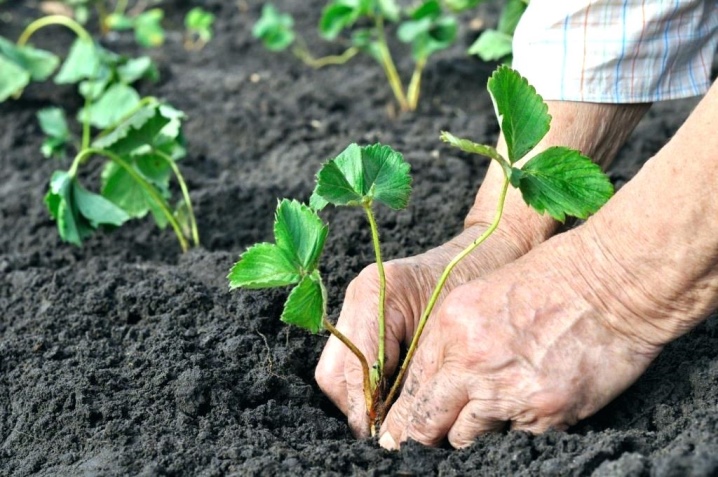
Timing
It is very important to take into account climatic features when choosing the timing for a transplant, namely:
- when the first frost occurs;
- how long the warm season lasts;
- how often precipitation falls.
Important! Usually, strawberries are transplanted into open ground no later than 1 month before the first frost. Then the young bushes have time to take root and get stronger, and then delight them with a luxurious harvest.

In the Moscow region, it is customary to transplant from mid-August to the end of September. You can plant on open soil or use agrofibre. In the second case, the strawberry harvests earlier. Planting times may vary depending on temperature. The last planting can be done no later than 30 days before the first frost.
In the Urals, the planting period should be adhered to from mid-August to the second half of September. You can plant both in open soil and under agrofibre. If you do planting in the fall under a black film, then the harvest will be about 2 weeks earlier than it should be in terms of time. If the strawberries are planted in open ground, but precipitation often occurs, then it is better to cover it with a film.
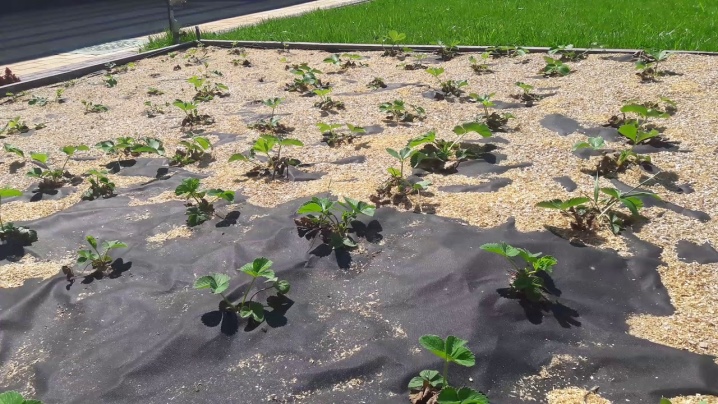
In Siberia, planting is carried out in early autumn, it is better to start this process from the end of July and later than mid-August. But if the deadlines have passed, then you can transplant strawberries, but only in a greenhouse or under a black film.
If we consider the middle lane, for example, the Leningrad region, then it is better to do the transplant work from the second half of August to the second half of September, only one month. In the Rostov region or in the Krasnodar region, you can plant strawberries later - even in October. The main thing is that the air temperature must be suitable. In the south, the weather is warm for quite a long time..
Many experienced gardeners recommend taking into account the planting number, while you should pay attention to the lunar calendar.
Among the favorable days of April, it is worth highlighting the following days: 15-17, 24-26, 29 and 30. If it is decided to plant in September, then it is recommended to adhere to the following dates: 1-5, 7-10 and 17-24.

How to transplant correctly?
In order to correctly transplant strawberries in the fall, it is advisable to adhere to the following algorithm of actions:
- Initially, you need to remove all plants that are frozen, rotted or withered.
- All bushes that are healthy must be dug out together with a lump of soil.
- Dig up the soil, where the garden strawberry will grow in the future, and make holes, while the distance between the roots should be 0.3–0.4 m, therefore, the holes should be at the same distance, sprinkle sand on the bottom of the hole.
- When planting, you need to adhere to a simple rule - the bush must be planted not very deep and not very high, while all the roots must be carefully sprinkled with soil.
- When all the bushes have been planted, you need to once again compact the earth in the circle of plants, and then loosen the top layer a little.
- After about 14 days, you can fertilize with complex fertilizers.
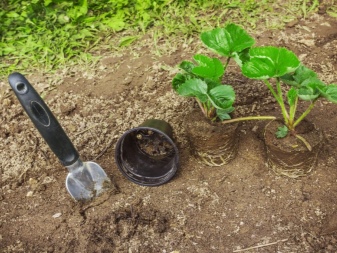
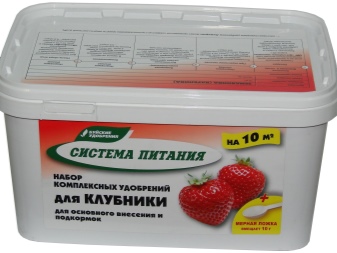
It is advisable to adhere to the following rules so that after transplanting the bushes take root well, grow quickly and give a lot of berries:
- it is better to choose slightly acidic soil for transplanting;
- the ground should be loose and light;
- if the planting will be done on loam, you first need to use a bucket of sand for 1 square meter;
- peat is used to improve the condition of sandy loam soil, but for strong acidified soil, another 400 grams of calcite, dolomite flour or slaked lime will be required per 1 square meter.

Important! Many strawberry varieties, including the popular Victoria variety, grow well after greenery, various legumes, beets, radishes or carrots. But after potatoes, cucumbers, tomatoes or cabbage, strawberries do not give a good harvest.
It is better to choose an area protected from the wind. An excellent choice would be an area with a slope of 5 degrees, since in this case water will not accumulate in the pits during heavy precipitation, and in fact moisture interferes with obtaining a good harvest.
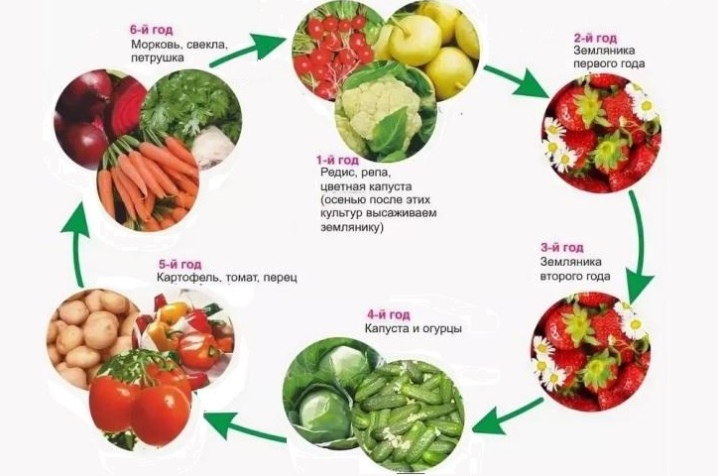
Mustache
For rejuvenation or propagation of strawberries, you can use mustaches or vegetative shoots. The plant should have at least 15 pieces, then it is suitable for further work. Usually this method is used in the second half of the summer. 3-4 strongest shoots are taken from one adult bush, then all the rest are cut off so that the plant does not waste energy on them. It is necessary to prepare plastic cups, make holes for drainage in them. The antennae are rooted in these containers - the rosette is strengthened with wire, sprinkled with soil and left near the mother bush for 1–1.5 months.
Then you need to wait for the rooting of the antennae and the appearance of 3-5 leaves, after which they can be separated from the mother plant and already planted separately. Initially, prepare the holes at a distance of 0.3 m between themselves and 0.6 m between the rows, they should be thoroughly watered with water. Their depth should be from 0.2 to 0.25 m. The seedling is placed in the hole along with a lump of earth, covered with soil and watered with Fitosporin solution. You can water both the ground and the seedling, its leaves and under the root. Further, the beds should be mulched.

Sapling
Two-year-old plants are characterized by excellent survival rate and high productivity. Usually, one-year-olds are still weak for transplanting, and three-year-olds already have a lower productivity.
It is recommended to immediately plant young seedlings in a new bed, while the roots have not yet dried up. Previously, the roots should be examined for rot, the presence of pests and diseases. All damage must be removed with a sharp knife.
The cut sites are treated with charcoal, so the plants become protected from infection.

By dividing the bush
Plants can be transplanted by dividing the bush. Obushes are usually taken, which are only 2-4 years old. The beds that will be used for transplanting must initially be well watered. Each bush is carefully dug in, pryed off and taken out, the rest of the earth is shaken off. Then the root system is washed in a large amount of water and divided into several parts. A strong seedling must have two stems and healthy roots. All affected roots, shoots, leaves, peduncles are removed with a sharp instrument.
Next, you need to prepare a special solution, including 3 tablespoons of coarse salt and 1 teaspoon of copper sulfate per 1 liter of water. In this solution, it is necessary to soak the root part of the seedlings for one hour. A glass of rotted humus and wood ash is poured into the holes for planting. The seedlings are placed in holes and sprinkled with soil, tamped a little, watered and mulched.
Important! It is recommended to transplant, regardless of the method, exclusively in the evening or in cloudy weather.
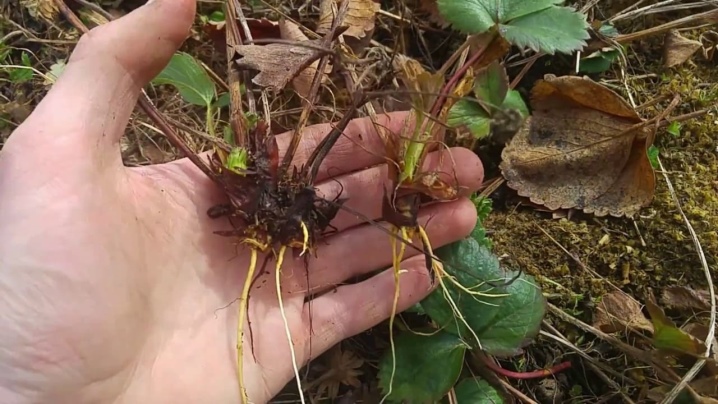
Follow-up care
After transplanting strawberries to a new place, they need follow-up care:
- regular watering;
- loosening the soil around the bushes;
- pest control;
- weed removal.
During watering, care should be taken to keep water out of the leaves.... The first 10 days after planting, it is recommended to water every day, in the future it can be shortened and carried out several times a week. If you pour strawberries heavily, it will disappear, so you should be guided by the level of its moisture. If the planting area is quite large, then drip irrigation will be the best choice.
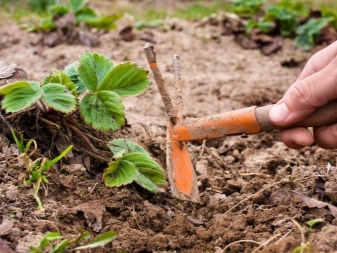

It is recommended to apply fertilizers only if fertilization was not done before planting the seedlings. You will not have to feed it additionally.
It is very important to care for strawberries even in cold weather.... The root system of an adult plant can only withstand soil temperatures up to -7 degrees, but young plants are rather weak to low temperatures.Experienced gardeners recommend mulching, then it takes root better. Can be used for shelter needles, straw, rotted pus, peat, sawdust and so on.
Only the roots are covered with mulch, not the whole plant. The snow cover perfectly protects the upper part of the plant from frost. If there is no snow, then it is better to protect the bushes with agrofibre or pine spruce branches. Already in the spring, all additional shelters should be removed, all dead or old leaves are cut off to renew the plants and give them strength.
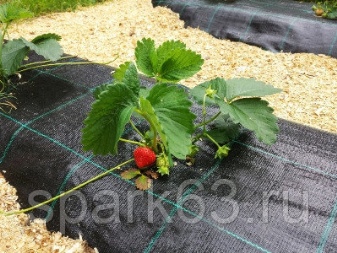
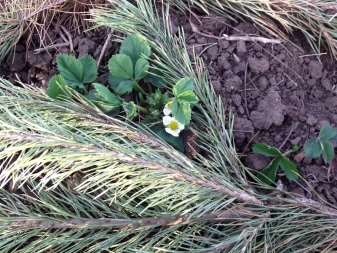
Professional advice
In order to correctly and effectively transplant strawberries in a new place in the fall, it is recommended to take into account the following expert advice:
- so that the strawberries get stronger to frost, it is recommended to plant it a month before a strong cold snap;
- it is better to carry out all work in cloudy hours or in the evening, since the sun's rays can lead to damage to plants;
- no need to transplant during or immediately after rain, it is better to wait a few hours;
- propagation of strawberries with a mustache should be done in early autumn;
- the harvest depends on the correctly selected place, soil and seedlings themselves;
- adult outlets that gave a good harvest are not suitable for transplanting, since in the future they will be unproductive;
- it is advisable to plant several varieties, and with different times for the appearance of berries, then all summer there will be fresh and tasty fruits;
- you can fertilize plants both during planting and after it;
- if pests or manifestations of a disease appear, you do not need to wait for their spread and immediately process the affected bushes.
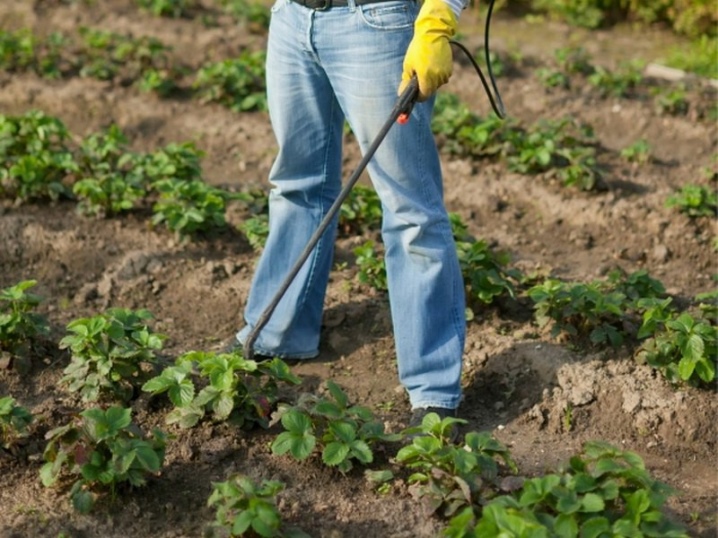













The comment was sent successfully.